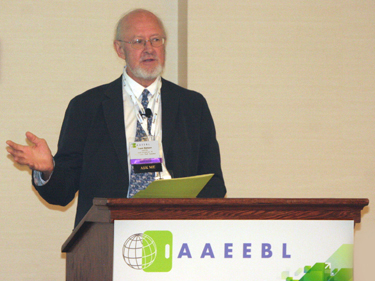ePortfolios | Viewpoint
A Profoundly Disruptive Technology
In Boston, from July 19 to 22, AAEEBL (The Association for Authentic, Experiential, and Evidence-Based Learning) had its first world conference. The success of this conference provided the proof of concept for a new kind of association in higher education: a tripartite group of learning and assessment experts, technology experts, and corporate representatives organized around a profoundly disruptive technology. [Below: Trent Batson speaking at the AAEEBL conference. Campus Technology staff photo.]

The technology is ePortfolios, and, because it is profoundly disruptive, few people understand what it does or how best to use it. This technology anticipates the learning and education models of the coming decades; it is not intended merely to support and extend existing models far into the future. But, the fact that nearly 300 people came to Boston from around the world to learn more about this technology and how to deploy it is a testament to the power of the portfolio idea.
I know that most people reading this article have been hearing about ePortfolios for years, may have tried a pilot implementation or a full implementation, or may have just decided to wait. Some may have concluded that ePortfolios are not necessary or important. ePortfolios were hot in 2005 and might now seem passé. If ePortfolios are low on your list of priorities, or not even on the list yet, you are probably being reasonably cautious--as you would be about any emerging technology. We all recognize a typical pattern in technology infusion in higher education: a buzz developing around a new kind of technology that seems to address a number of needs followed by cautionary messages--red flags--and then the tales about how the new hot technology is not really quite as sensational as it seemed.
Or, you may know enough about ePortfolios to know that implementing ePortfolios requires extensive planning and change, and so, again, you are inclined to wait.
At the conference in Boston (co-located with Campus Technology 2010), however, we heard from nearly a hundred institutions about their ePortfolio work. Most attendees were stunned to see how widespread the portfolio movement is, not only in the United States, but internationally.
AAEEBL brought together leaders and practitioners who are equally comfortable talking about teaching, learning, and assessment as about the technology. These leaders and practitioners presented in some cases with their vendor representatives. The AAEEBL community gives equal standing and support for all three groups: the theorists and researchers, the techies, and our corporate affiliates.
What drives AAEEBL and ePortfolio activists around the world is the realization that the portfolio revolution, though gradual, will eventually succeed. It is gradual because it depends on turning teaching and learning upside down. We know that eventually all students will have a portfolio of one kind or another because this mobile age demands that they do. But we also know that education cannot make a profound change in a short time.
ePortfolios, as tools, allow students to have their own set of management tools that they control and own so their learning is longitudinal instead of episodic. (Their ePortfolio account does not disappear after a course but continues.) Their seat of learning is within their own sphere and not within the institutional systems. Their teacher’s job becomes helping them build their portfolio in each course. The sequence of courses, then, is bound together by the cohesion power of the portfolio.
AAEEBL attendees in Boston, after four content-packed days of sessions covering nearly every aspect of ePortfolios, shared their enthusiasm for the technology and delighted in the wide array of sessions. Many existing organizations--The Association of American Colleges and Universities, the LaGuardia Community College’s Making Connections National Resource Center, the Northeast Regional Computing Program (NERCOMP, affiliated with EDUCAUSE), and of course Campus Technology--co-hosted the event and helped create the sense that the world ePortfolio community was coming together. Next year, AAEEBL plans to be co-located again with Campus Technology and will title its July 25-28 event “The World ePortfolio Summit.”
This conference and the creation of AAEEBL itself signal the rapid expansion of a particular market sector: online management tools for students. If students are going to manage their own learning experiences in class, in co-curricular and in non-curricular settings, they need a much richer array of management tools--tools for searching, tagging, aggregating, exporting, and displaying--than they have now. If the industry thought selling management tools to 4,000 colleges and universities was attractive, it should look at the prospect of selling management tools to millions of students and understand the opportunity.
With the advent of AAEEBL, a global collaborative, the portfolio conversation has quickened, deepened, and broadened. Now, well past the trough of disappointment (see Gartner’s Hype Cycle), portfolio has a global association affiliated with all existing portfolio initiatives and organizations. The work is just beginning.
About the Author
Trent Batson is the president and CEO of AAEEBL (http://www.aaeebl.org), serving on behalf of the global electronic portfolio community. He was a tenured English professor before moving to information technology administration in the mid-1980s. Batson has been among the leaders in the field of educational technology for 25 years, the last 10 as an electronic portfolio expert and leader. He has worked at 7 universities but is now full-time president and CEO of AAEEBL. Batson’s ePortfolio: http://trentbatsoneportfolio.wordpress.com/ E-mail: [email protected]

